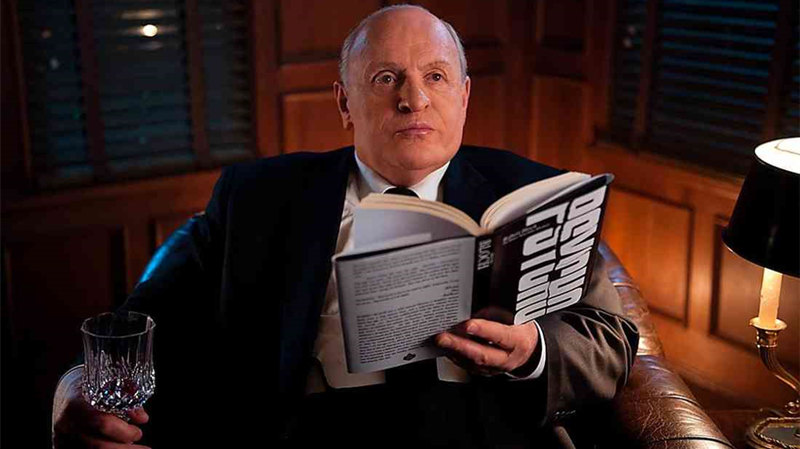“Humpty Dumpty sat on a wall,
Humpty Dumpty had a great fall;
All the King’s horses, and all the King’s men
Cannot put Humpty Dumpty together again.”
The phrase “inspired by actual events” is a well-worn device in Hollywood filmmaking, often connoting an inspirational sports story or an exhilarating war drama. It is seldom that the true events and the cinematic reenactment of them bear much relationship to one another, and it is even more seldom that the results are all that inspiring or elevating. Double that for anything having to do with politics. So it’s reassuring to see how well “All the President’s Men” turned out in 1976; it’s not only a thoroughly gripping, real-life political thriller based on the Watergate scandal and the downfall of President Richard Nixon, it’s darned good filmmaking, too. Now, we get it in high-definition Blu-ray.
Yes, I’d call it a thriller; maybe not in the sense of a full-blown, melodramatic, cloak-and-dagger espionage saga or an action-packed whodunnit but in the sense of an exciting and tension-filled movie. It’s a feat made all the more remarkable for our knowing practically everything that’s going to happen in the story line because the real-life events made front-page news all over the world for decades.
Screenwriter William Goldman based “All the President’s Men” on the book of the same name by “Washington Post” reporters Carl Bernstein and Bob Woodward. Alan J. Pakula (“The Parallax View,” “Klute,” “Sophie’s Choice,” “The Pelican Brief”) directed and Dustin Hoffman and Robert Redford star as the two fledgling reporters who broke the case. The adventure begins in 1972, at a time when neither of the young men was an important journalist at the newspaper. In fact, they were practically less than negligible: Woodward had only been with the paper for nine months, and Bernstein was on the verge of being fired. But they took the fragmented beginnings of a minor story and doggedly pursued it to its momentous conclusion, which ended up with the toppling of a corrupt Presidency and the two reporters becoming folk heroes to a generation of aspiring journalists.
The movie begins with the break-in of the Democratic National Committee headquarters in the Watergate Office Building. The police caught and arrested five men trying to bug the offices. The “Post” sends Bob Woodward (Redford) to cover the arraignment of the burglars, an assignment not thought to be of much consequence. Until Woodward becomes suspicious. It seems the burglars somehow obtained their own defense counsel without even making a phone call. Moreover, the men identify themselves to the judge in odd ways. The first man introduces himself as “Bernard Barker, anticommunist”; and the next man as “James McCord, security consultant…recently retired…from the Central Intelligence Agency.” Upon further investigation, Woodward discovers that all five men had CIA ties. At which point Woodward’s editors, Harry Rosenfeld (Jack Warden) and Howard Simons (Martin Balsam), decide to pursue the story and team Woodward up with another young reporter, Carl Bernstein (Hoffman). As the movie would have it, Bernstein is the more impulsive of the two, playing his hunches; Woodward is the more cautious, always looking for more substantiation.
What the reporters discover is that the attempted bugging of the Democratic headquarters was only the tip of the iceberg. As Woodward and Bernstein (or “Woodstein” as the two men become affectionately known at the paper) dig further, they uncover a plot on the part of the Republican Committee to Re-elect the President (known as “CREEP”) illegally to use campaign funds to disrupt and bedevil the Democrats, nefarious operations that went far beyond Watergate, that probably affected the election of the President, and that had their roots deep within the White House itself.
Like all good detective work, most of the reporters’ job is on the telephone or knocking on doors. “Hello,” says Woodward on the phone to Howard Hunt, a member of the White House Special Investigations Group, “I’m Bob Woodward of the ‘Washington Post.’ I was just kind of wondering why your name and phone number were in the address books of two of the men arrested at Watergate?” Hunt’s response: “Good God!”
Little by little, over a period of two years, the reporters inched their way toward the Oval Office, thanks in no small part to the encouragement of the “Post’s” head man, Executive Editor Ben Bradlee (Jason Robards, who bore an uncanny resemblance to the real man). “You guys are about to write a story that says the former Attorney General, the highest-ranking law enforcement officer in this country, is a crook. Just be sure you’re right.” And thanks to a mysterious figure nicknamed by Simons as “Deep Throat” (Hal Holbrook), who kept pointing the reporters in the right direction. Just follow the money,” he tells Woodward when they meet.
As things go on, we learn that CREEP, the fund-raising organization to re-elect Nixon, had a slush fund of almost a million dollars that it was using to finance dirty tricks like the break-in at Watergate and numerous other illegal activities. Worse, every higher-up in the Republican Party seemed either to be in on the operation or to know about its existence. The scandal would eventually implicate the CIA, the FBI, and the Justice Department in covert operations. It was Nixon’s denial of any part in the misconduct and the subsequent revelation that he knew all along what was happening that lead to his eventual resignation from office. In the meantime, while investigations were going on, the country reelected Nixon to the Presidency by a landslide vote.
All of the names familiar to the Watergate scandal play a part in the movie. Besides the ones I’ve mentioned, we encounter among others former Attorney General John Mitchell, J. Gordon Liddy, H.R. Haldeman, John Ehrlichman, Hugh Sloan, Maurice Stans, Clark MacGregor, Herbert Kalmbach, Donald Segretti, Ken Clausen, Dwight Chapman, Richard Kleindienst, even Vice President Spiro Agnew.
As filmmaking, one can hardly fault “All the President’s Men.” Things start off with a literal bang, as the opening shot shows a close-up of a blank piece of paper in an electric typewriter and the sudden jarring crash of a key stroke. It is extremely effective in setting the tone for the explosive inquiry to follow, much of which takes place in the newspaper office and behind a typewriter. Another good shot has the two reporters sitting in the Library of Congress going through stacks of material as the camera, mounted overhead, pans farther and farther upward, slowing revealing the vast space and the tiny secrets the men were uncovering. Then, there are the celebrated scenes in the parking garage where Woodward meets Deep Throat, the episodes playing out in the shadows like a James Bond escapade.
“You can fool all the people some of the time, and some of the people all the time, but you cannot fool all the people all the time,” said another Republican President, Abraham Lincoln, a century earlier. Nixon and his cronies did fool all the people for quite some time, but eventually the truth came out. Thanks to Carl Bernstein and Bob Woodward and to books and movies like “All the President’s Men,” we can be proud that at least sometimes there are people on our side looking out for the public good.
Almost two-and-a-half hours of movie time go by in what seems like a third that length. It’s a further tribute to the director, writers, actors, and filmmakers responsible for this remarkable work. The Academy nominated “All the President’s Men” for eight Academy Awards, including Best Picture and Best Director, the movie winning Oscars for Best Actor in a Supporting Role (Jason Robards), Best Art Direction/Set Decoration (George Jenkins and George Gaines), Best Sound (Arthur Piantadosi, Les Fresholtz, Dick Alexander, and James E. Webb), and Best Screenplay (William Goldman).
Video:
Warner Bros. use an MPEG-4 codec and a dual-layer BD50 to bring the movie to high-definition Blu-ray disc in the best possible shape. However, due probably to the nature of the original print, the results vary from scene to scene. The image is in widescreen, of course, a theatrical ratio of 1.85:1. Nevertheless, even though colors are almost always rich and deep, the light-dark contrasts are often amplified, perhaps the result of so much location shooting and perhaps a conscious decision by director of photography Gordon Willis (who also did “The Godfather” films, among many others). As transferred here, these vivid, light-dark contrasts occasionally obscure inner detail and at times make facial tones look too strong. When it’s good, the picture quality is beautiful, and in areas where it’s overly dark, it’s only a little annoying. Then, too, one notices a good deal of natural print grain that reminds us we’re looking at a real motion picture. However, the grain is present not only in nighttime scenes but clearly visible in daytime shots as well, giving the image quality a distinctly gritty appearance.
Audio:
The WB engineers reproduce the sound via DTS-HD Master Audio 1.0 mono. Its clarity and definition are outstanding, if occasionally a bit harsh, and in the lossless format there is a more robust dynamic range than ever. But it’s still monaural, so understand that everything will be emanating from between the two front speakers. Since almost everything is dialogue, though, I doubt that anyone will notice.
Extras:
The extras carry over from the two-disc DVD edition, again in standard definition. First up is an audio commentary by producer and co-star Robert Redford. The commentary is a fine behind-the-scenes affair, with Redford extremely articulate in providing details of the filmmaking process as well as information on the key participants in the drama.
Next, we find three documentaries, all of them narrated by actor Hal Holbrook. The first is “Telling the Truth About Lies: The Making of All the President’s Men,” twenty-eight minutes long, containing observations from Robert Redford, Dustin Hoffman, screenwriter William Goldman, Bob Woodward, Carl Bernstein, Ben Bradlee, cinematographer Gordon Willis, and actress Jane Alexander. The second documentary is “Woodward and Bernstein: Lighting the Fire,” about seventeen minutes long, containing comments from L.A. “Times” reporter Greg Krikorian, journalist Linda Ellerbee, former news anchor Walter Cronkite, former editor Ben Bradlee, director Oliver Stone, and various other media bosses, magazine editors, and political writers. They all sing the praises of the star reporters as well as comment on the state of journalism today. The third documentary is “Out of the Shadows: The Man Who Was Deep Throat,” sixteen minutes long, providing background on the man who in 2005 revealed himself as the celebrated mystery man, “Deep Throat.” He is W. Mark Felt, the former number-two man at the FBI in the early 1970’s. As Holbrook tells us, “Had Hollywood invented it, no one would have believed it.”
The extras conclude with the ten-minute vintage documentary, “Pressure and the Press: The Making of All the President’s Men”; a TV interview with the supporting actor, “5/27/1976 Dinah! With Jason Robards”; thirty-two scene selections; English, French, German, Italian, Portuguese, and Spanish spoken languages; French, Danish, Dutch, Finnish, Norwegian, Portuguese, and Spanish subtitles; and English, German, and Italian captions for the hearing impaired.
Finally, the disc comes housed in the back of a handsome, forty-page Blu-ray Book, filled with pictures from and text about the movie.
Parting Thoughts:
“All the President’s Men” shows how tough, diligent, investigative newspaper work can pay off. It shows how somebody has to keep an eye on a government run amuck when there is nobody within government to oversee the legality of what’s going on except those people involved in the wrongdoing themselves. It shows how absolute power can corrupt absolutely. And it shows how good filmmaking can make even a familiar story come alive all over again.
“I am not a crook.” –Richard M. Nixon.
Former President Nixon resigned from office on August 9, 1974, two years and several months after the “Washington Post” investigation began.


